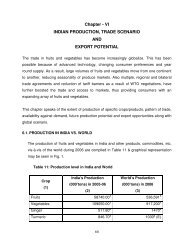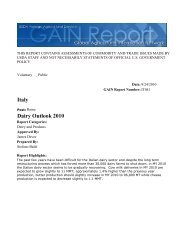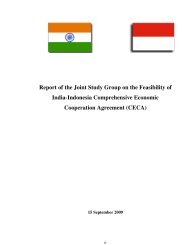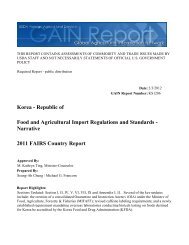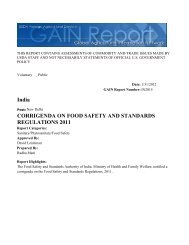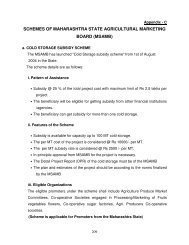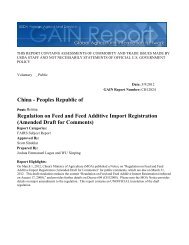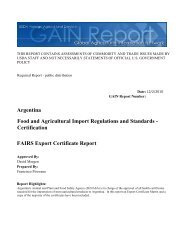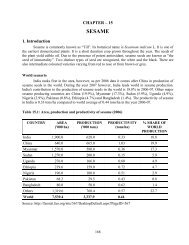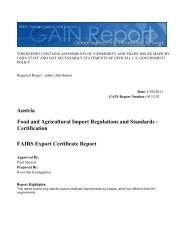Download - APEDA Agriexchange
Download - APEDA Agriexchange
Download - APEDA Agriexchange
Create successful ePaper yourself
Turn your PDF publications into a flip-book with our unique Google optimized e-Paper software.
Chapter- V<br />
INTERNATIONAL TRADE REQUIREMENTS<br />
International trade in fruits and vegetables has expanded more rapidly than trade in other<br />
agricultural commodities especially since the 1980s. Global fruit and vegetable trade has<br />
increased from $ 3.4 billion in 1961 to $ 90.48 billion in 2006. There is enormous diversity<br />
in fruits and vegetable trade, because of increase in variety of offerings. Advanced<br />
technology and trade agreements have played a major role in allowing access to markets<br />
and in promoting trade. In this backdrop, the understanding of the requirements of the<br />
international trade is very much required to accelerate the process. The requirements of<br />
International trade are classified into two group’s i.e. legislative and non-legislative<br />
requirements which are illustrated below:<br />
(a) Legislative requirements<br />
(i) Tariffs<br />
(ii) Non- tariffs – quality standards, MRL’s, marking, labeling, better<br />
packaging, contamination etc.<br />
(b) Non- legislative requirements<br />
(i) Good Agricultural Practices<br />
Legislation for tariff barriers has been mainly enacted by the countries with a view to<br />
protect the farmers, whereas legislation for non- tariff barriers like quality standards etc.<br />
have been framed in the interest of consumers. Substantial reduction in tariff barriers is<br />
essential to further enhance the global exchange of fruits and vegetables. In this regard,<br />
regional trade agreements, negotiated bilateral free trade agreements and further<br />
liberalization as a result of WTO negotiations, will eventually result in lowering the barriers<br />
to trade and better access.<br />
Requirements of tariffs and non-tariffs for different countries i.e. European Union, CIS<br />
countries like Russia and Ukraine, ASEAN countries, GCC countries, Australia, Japan,<br />
29
Korea, China and U.SA, are presented below. These requirements are based on Volume –<br />
IV (B & C), of International Market Research covering Trade Scenario and Specifications.<br />
5.1. REQUIREMENTS OF EUROPEAN COUNTRIES<br />
The EU is the leading destination and source of supply in global trade of fruits and<br />
vegetables. In the EU, all member countries have not only a common tariff for third<br />
countries, but also a common market organization with policy mechanism and trade<br />
agreements to stabilize the market for fruit and vegetables sector. Details of both<br />
legislative and non-legislative requirements are given below:<br />
5.1.1. Legislative Requirements<br />
(a) Tariffs<br />
• Generalized System of Preferences (GSP) Scheme<br />
Under this initiative, tariff exceptions have been made for developing and least<br />
developing countries. These countries have duty free access to EU round the<br />
year for fruits and vegetables except for banana.<br />
• Special regulatory requirements for banana<br />
Imports of bananas into the EU are regulated by tariffs and quota since 2006.<br />
Early tariff quota structure has been replaced by a single tariff (Euro 176 per ton)<br />
without quota restriction. For bananas from ACP (African, Caribbean and Pacific<br />
countries) countries, a zero duty is applicable up to the first 7, 75,000 tons net<br />
weight annually. The quantum is distributed among ACP countries on a first<br />
come, first serve basis.<br />
• Spices<br />
Import duties on most raw spices like pepper, cinnamon, cardamom, coriander<br />
seeds, cumin seeds, ginger, turmeric, curry, etc. are nil. However major spices<br />
that attract duties are vanilla (2.1%), cloves (2.8%) and mixture of spices (2.3%).<br />
30
• Other commercial crops/products<br />
Imports of sesamum seeds, soyameal and cotton from GSP countries is<br />
duty free.<br />
(b) Non Tariffs<br />
Many other aspects, comprising quality standards, labeling and marking, MRL’s,<br />
hygiene of food stuff, contamination, packaging standards, etc. should also be<br />
considered while exporting to EU markets. The quality standards of India which are<br />
being adopted by exporters meet the EU requirements.<br />
5.1.2. Non legislative requirements<br />
Non legislative requirements include environmental, ethical and social policies.<br />
(a) Bench Marking Food<br />
There are a number of non legislative standards that have to be adopted on a<br />
voluntary basis. Many buyers may ask suppliers to comply on environmental,<br />
health, safety, traceability, good agricultural practices and social responsibility<br />
issues. Details of which are given in the following paragraphs:<br />
• Food quality<br />
Complete traceability from the field to final consumers is required. A set of<br />
standards have been established through the production chain and in audit<br />
system for verification.<br />
• Social impact<br />
Social impact comprises occupational health, child labour, forced labour,<br />
minimum wages, etc. This aspect aims to ensure that reasonable conditions for<br />
workers are provided based on ILO conventions and ISO management system.<br />
31
• Environment friendly production<br />
It requires that food is produced with a minimum damage to the environment<br />
using sustainable farming system.<br />
• Good Agricultural Practices<br />
EUREPGAP which is now known as GLOBALGAP is already quite popular<br />
among Indian farmers and most of them are covered under registration.<br />
5.1.3. Trade and Consumer Preferences<br />
(i) General preferences<br />
General preferences of consumers are given below:<br />
• New and Exotic products<br />
Exotic items are becoming common and popular like mango, papaya,<br />
pomegranates, Physalis, etc. that have decorative attributes also, Similarly there<br />
is lot of demand for small products comprising mini cucumbers, mini sweet<br />
peppers, cherry tomatoes, etc.<br />
• Uninterrupted Supply<br />
Because of new health trends, consumers prefer the supply of the fruits and<br />
vegetables, which are made available by mostly countries in Southern<br />
hemisphere, African countries, India and Pakistan throughout the year.<br />
• Changing Life style<br />
There is increased demand for processed items such as pre-cut-washed and<br />
scraped-peeled-prepared items.<br />
• Food Safety<br />
Because of food safety concerns, there is demand for organic fruits and<br />
vegetables mainly in Germany, Sweden, Denmark, France and UK. Social<br />
awareness has also led to increased demand for “Fair trade” certified products.<br />
32
(ii)<br />
Specific product preferences<br />
EU Market requirements<br />
(a) Mango<br />
The details of market requirements of mango are described in brief:<br />
• International quality standards<br />
Already well adopted in India as Codex Alimentarius standards<br />
• Minimum Labeling<br />
It is well documented and exporters are aware of the requirements like:<br />
o Name and address of exporters/ packers<br />
o Name of product/ variety<br />
o Origin of produce<br />
o Class or grade<br />
o Size<br />
o Weight<br />
• Packaging<br />
Mangoes are packed in a single layer in fruit cartons (telescope or single piece<br />
folding) Fruits are wrapped in paper or padded.<br />
• Import regulatory documents<br />
o Phytosanitary certificate from the country of origin<br />
o Certificate of origin on GSP Form A for developing and least developed<br />
countries<br />
• Specific Market trends and preferences<br />
o Market for mangoes is growing because of improvement in quality, longer<br />
shelf life and shift from air to sea freight with bulk deliveries at competitive<br />
prices.<br />
33
o Coloured mangoes are preferred over green varieties<br />
o Many consumers prefer pre-peeled and pre-cut (ready to eat).<br />
o Multiple retailers have already started responding to the demand.<br />
(b) Pineapples<br />
♦<br />
Market requirements<br />
International quality standard (Codex Alimentarious standards for pineapples) is<br />
followed in India. The labeling and import regulatory documents are the same<br />
as given for mango.<br />
♦<br />
Specific Market trends and preferences<br />
• Germany, Italy and UK are the largest markets. Costa Rica is the<br />
leading supplier followed by Ivory Coast, Ghana, Ecuador, Brazil, etc.<br />
• EU market is growing and there is demand for new varieties like Baby,<br />
MD2.<br />
• As it is cumbersome to cut pineapple. Some African countries supply<br />
value added pre-cut packed or ready to eat pineapples to Europe.<br />
• UK and France prefer 0.9 kg to 1.5 kg fruits.<br />
• UK prefers 2/3 colour stage at destination.<br />
• Crown must be free of dried and dead leaves and its leaves must be<br />
fresh, turgid and green.<br />
• Preferences are for uniformity in colour and size in a pack.<br />
34
(c) Spices<br />
Import Regulations and Requirements<br />
♦ Quality standards - Sanitary and Phytosanitary<br />
The standards of most importing countries carry specification on micro cleanliness.<br />
The ESA and ASTA guidelines are in use all over the world. The details of which<br />
have been given in Report on International Market Research Volume - IV C (i) and<br />
are summarized below (Table 1).<br />
Table 1: ESA quality specifications<br />
S.No. Specification<br />
Ginger Turmeric<br />
Whole Ground<br />
1 Extraneous matter % 1 1 1<br />
2 Foreign matter % 2 2 2<br />
3 Ash % w/w max (ISO) 8 (ISO) 8 (BSI) 9(ISO)<br />
4 Acid insoluble ash % w/w max 2(ESA) 2(BSI) 2.5 (ESA)<br />
5 Maximum water % w/w max 12 (ISO) 12(BSI) 10 (ISO)<br />
6 Volatile oil 1.5 (ISO) 2.5(BSI) 1.5 (ESA)<br />
7 Microbe<br />
a. Salmonella abs in 25 g, yeast<br />
& molds<br />
b. E. coli<br />
105/g target, max 106/g absolute<br />
102/g target, max 103/g absolute<br />
Source:http//www.espspices.org/content/pdts/ESAQualityMinimalDocument191104.pdp<br />
BSI: Bureau Standards Institute<br />
ESA: European Spices Association<br />
ISO: International Organization for Standardization<br />
35
American Spices Trade Association has fixed its own specifications which are given<br />
in Table 2<br />
Table 2: ASTA Cleanliness Specifications for spices<br />
Specification<br />
(1)<br />
Units<br />
(2)<br />
Ginger<br />
(3)<br />
Turmeric<br />
(4)<br />
Whole insects dead by count 4 3<br />
no/pound<br />
Excreta mammalian by mg/pound 3 5<br />
Excreta other by mg/ pound 3.0 whole 5.0<br />
10.0 split<br />
Mold % by wt 3 1.0<br />
Insect inflated/infested % by wt 3 1.0<br />
Extraneous/foreign<br />
matter<br />
% by wt 1.0 for whole<br />
0.5 for splits<br />
0.5<br />
Source: 1) Booklet, Dried ginger for exports, Spices Board, Cochin<br />
2) Booklet, Turmeric for export, Spices Board, Cochin.<br />
♦<br />
Microbial load<br />
Microbial contamination mainly arises from improper post-harvest handling and<br />
storage. Proper drying and storage can reduce the microbial contamination. Markets<br />
prefer a “clean” product rather than “cleaned”. Use of ethylene oxide is a popular<br />
method for eliminating microbial contamination, but its use has been banned in<br />
Europe and Japan. Sterilization by steam causes loss of volatile oil and flavour and it<br />
is costly. However irradiation process is cost effective and practical.<br />
36
♦ Aflatoxins<br />
Aflatoxins are extremely toxic metabolites (including B 1 , B 2, G 1, G 2, M 1, and M 2 )<br />
produced by fungi Aspergillus flavus and Aspergillus parasiticus. Maximum load for<br />
total aflatoxin has been set in almost all developed countries between 1 ppb and 20<br />
ppb. The use of scientific methods of handling and use of modern dryers can reduce<br />
the problem considerably.<br />
According to the EU direction 3347/99 Sept 2001, nutmeg, pepper, turmeric and<br />
ginger can have maximum 10 ppb total aflatoxins.<br />
♦ Trace metal contamination<br />
Hazardous metals are mercury, cadmium, arsenic, chromium and lead. The ESA<br />
specifications on trace metal contaminants in spices (limit in mg/kg) are lead 10,<br />
Arsenic 5, Copper 20 and Zinc 50.<br />
♦ Pesticide residues<br />
Tolerance limits in pesticide residues in EU are presented in Table 3.<br />
Table 3: Tolerance limits of pesticide residues in ppm<br />
Product DDT Endrin Heptachlor Captol Chlorophysiphos<br />
Spices 0.05 0.01 0.01 1.02 0.05<br />
♦ Other EU directives<br />
EU direction 1999/2/EC allows spices and herbs to be treated with ionizing radiation;<br />
however, consumer acceptance is very low. At the same time use of Ethylene oxide is<br />
banned in EU but it is accepted in USA. Therefore, the best way is to adopt scientific<br />
methods and modern dryers for eliminating microbial load, aflatoxins, etc.<br />
37
♦<br />
Hazard Analysis<br />
EU food hygiene directive (1993/43/EEC) requires food producing companies to do<br />
HACCP analysis to ensure appropriate food safety.<br />
♦<br />
Traceability<br />
Complete traceability from field to the final consumers is required in EU. A set of<br />
standards have been prescribed along with in audit system for verification.<br />
♦<br />
Packing<br />
Processed products should be packed in sealed, clean and sound paper cartons of<br />
0.5 kg to 2.0 kg properly lined with a waterproof paper or in moisture proof bags made<br />
of materials which do not impart any smell to the products. A suitable number of such<br />
packs should be packed in cardboard or wooden boxes. The size of cardboard boxes<br />
and number packs packed in a cardboard box is left to purchaser and seller.<br />
♦<br />
Marking<br />
The following particulars should be marked or labeled on each bag or container of the<br />
products:<br />
a) Name of the material and the trade or brand name, if any<br />
b) Name and address of manufacturers/packers<br />
c) Batch or code number<br />
d) Net mass<br />
e) Grade of the material (if graded) according to national standards<br />
f) Producing country<br />
g) Any other marking required by purchaser<br />
h) Year of production if known<br />
38
♦<br />
Storage and Transport<br />
The packs of spices should be stored in covered premises well protected from sun,<br />
rain and excessive heat. The store room should be dry, free from objectionable<br />
odours and proofed against entry of insects and vermin.<br />
The ventilation should be controlled so as to give ventilation under dry conditions and<br />
to be fully closed under damp conditions. In a storage godown, suitable facilities<br />
should be available for fumigation. The packs should be so handled and transported<br />
that they are protected from rain, from the sun, or other sources of excessive heat,<br />
from objectionable odours and from cross infestation especially in the holds of ships.<br />
5.2. CIS COUNTRIES - RUSSIA, UKRAINE AND KAZAKHSTAN<br />
♦ Tariff structure<br />
In Russia, there is a high tariff for tomato depending upon season of export. For<br />
mango, banana, pineapple and grapes there is a tariff ranging from 3.75% to 4.85%.<br />
Tariff for soyameal is 3.75% for GSP countries and sesame can be exported free of<br />
duty to Russia.<br />
For Ukraine tariff duties for mango and banana is 3% which is quite low but for grapes it<br />
is 10%. For soyameal and cotton, the duties are also low 5% and 0% respectively, but<br />
tariff duties for sesame are high i.e 20%. Tariff duties for tomato and onion for exporting<br />
to Ukraine are also very high.<br />
For Kazakhstan, fruits like mango, grapes, banana and pineapples can be exported<br />
with a tariff of 3.75%. However, for exporting tomato, onion and green chillies a tariff<br />
duty of 11.25%, 15% and 15% respectively will have to be paid. For exporting<br />
soyameal and sesame a tariff duty of 3.75% will be charged. But cotton can be<br />
exported duty free.<br />
39
The tariff structure for these countries is given in Table 4.<br />
Table 4: Tariff Rates in Russia, Ukraine and Kazakhstan<br />
Commodity<br />
Russia<br />
Tariff rates in %<br />
(GSP Ukraine<br />
Kazakhstan<br />
Tariff)<br />
(General Tariff)<br />
(GSP Tariff)<br />
Mango 3.75 3.00 3.75<br />
Grapes 3.75 10.00 3.75<br />
Pomegranate - - -<br />
Lychees - - -<br />
Banana 4.85 3.00 3.75<br />
Pineapples 3.75 4.00 3.75<br />
Tomato 16.57 – *25.98 100.96 11.25<br />
Onion 11.25 20.00 15.00<br />
Green chillies 11.25 - 15.00<br />
Ginger - - -<br />
Turmeric powder - - -<br />
Soyameal 3.75 5.00 3.75<br />
Sesame 0.00 20.00 3.75<br />
Cotton - 0.00 0.00<br />
Source: ITC Trade map<br />
* Duty varies depending upon season of exports<br />
5.3. REQUIREMENTS OF ASEAN COUNTRIES<br />
♦ Tariffs and Protocols<br />
Understanding tariffs and protocols of ASEAN countries is absolutely essential as all<br />
these countries are in the neighbourhood of our country and we have specific<br />
interest/inclination to export the farm produce and other commodities to these<br />
40
countries. In this document, only six countries namely Thailand, Indonesia,<br />
Philippines, Malaysia, Vietnam and Singapore have been covered. The present state<br />
of tariffs and protocols which are necessary to follow are described in following<br />
paragraphs:<br />
I. Tariffs<br />
Export of mango, grapes and pomegranates to Thailand is free of duty as a<br />
result of India-Thailand Free Trade Agreement w.e.f. 1/03/2006. However, high<br />
import duty is imposed on lychees, bananas, pineapples, tomato, onion, green<br />
chilly, ginger, turmeric powder and sesame. Export of cotton is also duty free<br />
whereas a duty of 6% is levied on export of soyameal.<br />
Indonesia has imposed 25% tariffs on import of mango and onion, whereas<br />
import of soyameal and cotton is without any tariff. Imports of all other items<br />
attract a tariff of 5%.<br />
Export of onion, green chillies, and ginger to Philippines attracts tariff of 40%,<br />
20% and 20% respectively. Similarly items like mango, banana, lychees,<br />
pineapples and tomato are imposed tariffs in the range of from 10 to 15%.<br />
However, other commodities like grapes (7%), turmeric powder (3%), soyameal<br />
(3%), sesame (7%) and cotton (1%) are imposed with lower tariffs.<br />
Malaysia imposes lowest tariffs as there is no tariff on tomato, onion, green<br />
chillies, ginger, turmeric powder, sesame and soyameal. There is 60.82 $/ton<br />
tariff on mango, tariff of 364.96 $/ton on bananas, 228.17 $/ton on pineapples<br />
and 5% tariff on grapes & lychees. Export of cotton to Malaysia attracts a tariff of<br />
10%.<br />
Tariffs imposed by these four ASEAN countries on imports are detailed in Table 5.<br />
41
Table 5: Current tariff rates in ASEAN countries<br />
Commodity<br />
Tariff rates in %<br />
Thailand Indonesia Philippines Malaysia<br />
Mango free 25 15 60.82$/ton<br />
Grapes free 5 7 5<br />
Pomegranate free - - -<br />
Lychees 40% or 852.74 $/ton 5 10 5<br />
Banana 40% or 852.74$/ton 5 15 364.96$/ton<br />
Pineapples 40% or 852.74$/ton 5 10 228.17 $/ton<br />
Tomato 40% or 108.18$/ton 5 10 0<br />
Onion 60% or 159.09 $/ton 25 40 0<br />
Green chillies 40% 0r 108.18 $/ton 5 20 0<br />
Ginger 27% or 95.46 $ /ton 5 20 0<br />
Turmeric powder 27% or 95.46 $ /ton 5 3 0<br />
Soyameal 6 0 3 0<br />
Sesame 30 5 7 0<br />
Cotton 0 0 1 10<br />
Source: ITC Trademap (www.trademap.org)<br />
*According to India-Thailand Free Trade Agreement, exports of mango, grapes and<br />
pomegranates to Thailand are free<br />
(a) Vietnam<br />
Tariff structure<br />
General tariff for imported food articles as per www.trademap.org are, as follows:<br />
42
Product<br />
Ad Valorem<br />
1) Fresh onions, tomatoes and green chillies 30%<br />
2) Fresh bananas, guavas, mangoes, grapes etc. 40%<br />
3) Sesamum seeds 10%<br />
4) Cotton Nil<br />
(b) Singapore<br />
Tariff structure<br />
Tariffs on imported fruits and vegetables as per www.trademap.org, are applied on the<br />
basis of MFN duties (Most Favoured Nation), details of which are given below:<br />
Product<br />
MFN duties<br />
1) Fresh onions, tomatoes and green chillies Nil<br />
2) Fresh mangoes, grapes, pineapples, bananas, Nil<br />
and Litchi.<br />
3) Sesamum seeds, soyameal and cotton Nil<br />
With the signing of India-Singapore Comprehensive Economic Cooperation Agreement<br />
(CECA) there is free trade between India and Singapore.<br />
II. Other Non-tariff Requirements<br />
(a) Thailand<br />
(i) Sanitary and Phytosanitary aspects<br />
Sanitary and phytosanitary certificate is required from the exporting country.<br />
However, there is no post-entry quarantine. Also no radiation certificate is<br />
required. Products, however, must be free of pests of quarantine concern.<br />
43
(ii) Other requirements<br />
• Notice of intention to import must be given.<br />
• Hand written phytosanitary certificates are not acceptable.<br />
• All consignments must be labeled in Thai language giving<br />
o Generic and Trade<br />
o Registration number<br />
o Name and address of manufacturer<br />
o Date of manufacturing<br />
o Net weight of contents<br />
o Any additives used<br />
• Registration Food and Drug Administration<br />
o Registration with FDA is mandatory<br />
o While seeking registration apply with two samples of the product,<br />
details of exact composition by percentage of each ingredient and six<br />
labels.<br />
o For commodities of interest, an application can be made simply by<br />
submission of a completed Orr 6 form (which can be downloaded from<br />
http:www.fda.moph.go.th/eng/food/details/form Orr 6.stm.)<br />
o FDA can be contacted at:<br />
Food Control Division<br />
Tel: 66-2590-7186, 66-2590-7189<br />
Fax: 66-2591-8460<br />
E mail: food @ fda.moph.go.th<br />
(b) Indonesia<br />
(i) Quarantine requirements<br />
• Phytosanitary certificate is absolutely necessary from the country of<br />
origin by appropriate authority for all products.<br />
• The consignments are subject to plant quarantine inspection upon<br />
arrival in Indonesia.<br />
44
• No radiation certificate is required.<br />
• No import permit is necessary for exports of fruits and vegetables, but it<br />
is required for export of sesame seeds.<br />
• Pesticides regulations exist for fresh fruits and vegetables i.e. Maximum<br />
residue levels.<br />
• Products must originate from areas free of all types of fruit fly especially<br />
in fresh fruits. Vegetables must be free of pests of quarantine concern.<br />
• Fresh fruits may be required treatment of cold disinfestations up to 18<br />
days at 2.8°C and fumigation with methyl bromide prior to importation.<br />
• The above treatment is applicable to specific products for which local<br />
plant health authority should be contacted.<br />
(ii) Labeling<br />
• The use of Bhasa Indonesia is mandatory on all types of goods.<br />
Approval to omit Bhasa Indonesia labeling must be obtained from the<br />
Indonesian Authority General.<br />
• Labels for food products musto<br />
Indicate registration and issue of product no. (ML number) by<br />
the Food & Drug Control Agency.<br />
o Have an expiry date<br />
o Be in Indonesian language.<br />
o Have the complete name and address of importer<br />
o Have a halal certificate from an agency approved by Indonesian<br />
Islamic Council<br />
(iii) Registration<br />
• All food and beverages imported must be registered at the Indonesian<br />
Food and Drug Control Agency. For imported products, the registration<br />
process is completed by the Indonesian importers on behalf of foreign<br />
exporting companies before goods are shipped to Indonesia.<br />
45
• Special forms are available that contain procedures required to be<br />
followed.<br />
• It is obligatory to send samples for analysis to determine the<br />
ingredients, additives and microbiological content.<br />
• Can contact Food and Drug Control Agency<br />
Badan POM (NADFC)<br />
J1 Percetakan,Negara No 23<br />
Jakarta-10560, Indonesia<br />
Fax: 021-42884117<br />
E mail: informase @ pom.qo.id<br />
(c) Philippines<br />
Non tariff protocols / requirements<br />
(i)<br />
Import permit<br />
Import permit is required for exports of all fresh fruits, vegetables, sesame but<br />
not for soyameal or raw cotton otherwise it is required for all plants and plants<br />
products. This can be obtained from:<br />
The Director<br />
Bureau of Plant Industry<br />
Department of Agriculture<br />
692, San Andres St.<br />
Malate, Manilla, Philippines<br />
(ii)<br />
Radiation certificate<br />
It is not required.<br />
(iii) Phytosanitary certificate<br />
All goods transported to Philippines must have phytosanitary certificate from place<br />
of origin.<br />
46
Concerns<br />
• Products must originate from areas free of all types of fruit fly.<br />
• Products may be subject to cold disinfestations and should be<br />
declared on phytosanitary certificate.<br />
• Fruits must also be free of san jose scale, oriental fruit fly and codling<br />
moth.<br />
• All fresh vegetables must be free of pests of quarantine concern.<br />
(iv) Food regulations<br />
All food regulations are based on Codex Alimentarius Commission.<br />
(v)<br />
Registration<br />
Food and Beverage products are required to be registered with the Bureau of<br />
Food and Drug (http:// www.doh.gov.ph/bfad.2/main.htm) prior to being sold in<br />
Philippines market. Food registration is the responsibility of Philippians importer /<br />
agent/ distributor.<br />
(vi) Labeling<br />
All goods must have a label in English or Filipino showing:<br />
• Common or generic name<br />
• Physical or chemical composition<br />
• Preparation and storage direction<br />
• Name and address of manufacturer/packer<br />
• Country of origin<br />
• Net contents<br />
(d) Malaysia<br />
Non - tariff protocols /requirements<br />
All aspects of food standards in Malaysia are regulated under Food Act 1983 and Food<br />
Regulation 1985.<br />
47
(i) Import permits<br />
No import permits are required for export of fruits, vegetables, sesame and raw<br />
cotton to Malaysia and if required it should be obtained from Director General of<br />
Agriculture, Kuala Lampur.<br />
(ii) Phytosanitary Certificate<br />
Phytosanitary certificate is required for export of mango and raw cotton; and it will<br />
be preferable to obtain Phytosanitary Certificate from the authorities in the country<br />
of origin.<br />
In case of mango, Phytosanitary certificate should declare it is free of mango seed<br />
weevil. All fresh fruits and vegetables will be inspected on arrival.<br />
Stored pests of concern (in case of sesame) are:<br />
i. Khapra beetle : Trogoderma granarum<br />
ii. Grain borer : Prostephasus truncatus<br />
All consignments of raw cotton must be free of weed seeds as below:<br />
i. Parthenium hysterophorus<br />
ii. Sorghum halpense<br />
iii. Rottboellia cochinensis<br />
(iii) Malaysian SPS and Food standards system<br />
Malaysia applies strict sanitary and phytosanitary measures for trade in plants,<br />
food products. The legislative and regulatory measures are covered under Rules of<br />
Plant Quarantine 1981 and Food Regulation 1983.<br />
Malaysian food standards and regulation require that food be processed, stored<br />
and handled in a sanitary manner which is applied to both domestic and imported<br />
products.<br />
48
(iv) Labeling<br />
Prepacked goods must include on the label<br />
o Type<br />
o Minimum quantity (weight) in metric scale<br />
o Name and address of manufacturer / importer, of country of origin<br />
o Language must be in Bhasa Malaysia or English<br />
o Labels must not include wording which are likely to be misleading<br />
(e) Vietnam and Singapore<br />
Non- tariff requirements are not available.<br />
5.4. GULF COUNTRIES<br />
(i) Tariff structure<br />
Examination of tariff structure of Saudi Arabia, UAE, Kuwait and Qatar shows that in<br />
Saudi Arabia there is no general tariff on the import of fruits and vegetables,<br />
whereas, in UAE, Kuwait and Qatar, there is a provision of imposition of MFN duties<br />
on the entry of some commodities, but for fruits and vegetables, no duties are<br />
charged. However on entry of ginger, turmeric, sesame seeds and cotton there is a<br />
tariff of 5%. For soyameal export, however, there is no duty.<br />
(ii) Non-tariff requirements<br />
Details of non-tariff requirements are not available with regard to Gulf countries.<br />
5.5. PACIFIC RIM COUNTRIES, CHINA AND U.S.A<br />
Tariff and non- tariff requirements of Australia, Japan, China and South Korea are<br />
discussed in the following pages:<br />
(i) Tariff structure<br />
The tariff structure on entry of fruits and vegetables, spices and other products is<br />
given in table 6.<br />
49
Table 6: Current Tariff rates applicable in Pacific Rim countries and China<br />
Countries<br />
Australia South Japan<br />
China<br />
Korea<br />
Product<br />
Tariff rate<br />
in %<br />
Ad<br />
Valorem<br />
Equivalent Tariff as<br />
applied MFN and<br />
Equivalent Tariff<br />
as applied MFN<br />
% GSP duties (%) and APTA<br />
duties (%)<br />
MFN GSP MFN APTA<br />
Mango 0 30 3.0 0 15 10<br />
Banana 0 30 20 # -25 ## - 10 6.9<br />
Pineapple - 30 17 - 12 7.9<br />
Lychees - - - - - -<br />
Grapes 5 45 7.8**-17*** - 13 -<br />
Pomegranates - - - - 13 -<br />
Tomato - 45 3.0 13 -<br />
Onion 0 27 8.5 - 13 6.5<br />
Green Chillies 0 - - - - -<br />
Ginger (Dried) 0 - - - - -<br />
Turmeric Powder 5 - - 0 - -<br />
Soyameal 0 3 4.2 - 9 -<br />
Sesame Seeds 0 40 0 - 10 9<br />
Raw Cotton - 0 0 - 40 -<br />
Source: www.trademap.org<br />
** If imported during the period from 1 st Nov to last of Feb.<br />
*** If imported during the period from 1 st of March to 31 st of Oct<br />
# If imported during the period from 1 st April to 30 th Sep<br />
##<br />
If imported during the period from 1 st Oct to 31 st March<br />
<br />
Tariff duty of 40% is applied to exports of sesame seeds to South Korea within quota.<br />
<br />
For export of cotton to China within quota, tariff duty of 1% is applied. But for<br />
exports beyond quota tariff duty of 40% is imposed.<br />
50
(ii) Non-tariff requirements<br />
(a) Australia<br />
(i) Import permit<br />
An import permit is required before sending any food product to Australia.<br />
Application for import permits can be carried out online at<br />
http//www.daff.gov.au/aqis/import/application/forms.<br />
However, some products are strictly prohibited and others are prohibited<br />
unless a specific Import Risk Assessment (IRA) is carried out.<br />
♦ Mangoes<br />
IRA for mangoes from India was started in April 2008. Provisional IRA has been<br />
released as there is already an IRA for mangoes from Mexico with established<br />
protocols and also Australian Quarantine Inspection Service recognizes Indian<br />
Directorate of Plant Protection and Quarantine & Storage as a competent<br />
authority to undertake pre-export inspection.<br />
However, until the provisional IRA is finalized, imports will not be allowed. Fruit<br />
flies, mealy bugs, red banded mango caterpillar and mango weevil are the pests<br />
of great concern to Australia.<br />
The recommended quarantine measures are pre-export irradiation treatment,<br />
supported by an operational system to maintain and verify quarantine status.<br />
Australian quarantine inspectors are also required to pre clear and verify the<br />
irradiation treatment of mangoes prior to export.<br />
♦ Turmeric (fresh)<br />
Turmeric fresh is prohibited into Australia unless a permit to export has been<br />
issued.<br />
51
♦ Turmeric (dried)<br />
• An import permit is not required, but a quarantine entry must be lodged for<br />
each consignment.<br />
• Material must be labeled with full botanical names, i.e. genus and species.<br />
• All the material must be thoroughly dried and not capable of propagation<br />
and must be free of prohibited seeds, live plant parts, live insects, soil and<br />
other quarantine risk material prior to arrival in Australia.<br />
♦ Ginger (fresh)<br />
Ginger fresh is prohibited for entry into Australia.<br />
♦ Sesame seeds – hulled<br />
• An import permit is required and must be applied prior to importation.<br />
• Quarantine entry must be lodged for each consignment.<br />
• Seed must be free of live insects, soil, disease symptoms, prohibited seeds<br />
and other plant material (leaf, stem, and pod material), animal material (e.g.<br />
animal faeces, feathers, etc.) and any other extraneous contamination of<br />
quarantine concern.<br />
• Each consignment must be packed in a new and clean packaging.<br />
• All commercial consignments require mandatory fumigation either pre or on<br />
arrival in Australia with methyl bromide @ 80g/m 3 for 48 hrs at 21 o C.<br />
• Pre-shipment fumigation is acceptable if the goods are accompanied by an<br />
official Phytosanitary certificate along with fumigation details.<br />
• On arrival, consignment must be inspected by a Quarantine officer to<br />
ensure that the goods are packed in gas permeable bags.<br />
• If the sesame is packed in gas proof packaging, the Phytosanitary<br />
Certificate must state that sesame seed was fumigated prior to being<br />
packed.<br />
52
(b) South Korea and China<br />
Non-tariff barriers<br />
Details of non- tariff protocols are not available for South Korea and China. However<br />
Japan has specific requirements for entry of mangoes from India.<br />
(c) Japan<br />
Non-tariff barriers<br />
For export of mangoes to Japan the requirement is to heat the mangoes with vapour<br />
heat at 46-49 o C for 20-30 minutes depending on the variety, to eradicate fruit fly.<br />
After treating the fruits with vapour heat, the fruits should be treated with hot water<br />
fungicidal solution and allowed to cool and dry before grading and packing.<br />
For details of vapour heat treatment and operational aspects of equipment, one can<br />
refer to guidelines from <strong>APEDA</strong> for export of mangoes to Japan.<br />
(d) U.S.A<br />
Non-tariff requirements<br />
Phytosanitary requirements for export of mango to U.S.A<br />
Import of mangoes from India is regulated under the “Fruits and Vegetables<br />
Quarantine procedures.” CFR 305 & 319. The brief requirements of Animal and<br />
Plant Health Inspection Service (APHIS) – USDA for entry of Indian mangoes into<br />
U.S.A are:<br />
• The mangoes must be treated in India with irradiation by receiving a<br />
minimum absorbed dosage of 400 gamma rays.<br />
• Importers must secure USDA import permit 30 days in advance of arrival of<br />
irradiated commodities at the scheduled port for further facilitation.<br />
53
• The mangoes must also be given post harvest hot water fungicidal<br />
treatment (Prochloraz at 500 ppm) at 52 o C for 3-4 minutes.<br />
• Each consignment must be inspected formally by USDA-APHIS and NPPO<br />
of India as part of the required pre-clearance inspection activities.<br />
• Each consignment of mangoes must be accompanied by a Phytosanitary<br />
Certificate issued by NPPO of India certifying that fruits received the<br />
required irradiation treatment and confirming that:<br />
i. Mangoes were subjected to post-harvest mitigation option as<br />
above<br />
ii. Mangoes were inspected and found free of Cytosphaera<br />
manigiferae, Macrophoma mangiferae and Xanthhomonas<br />
campestris cv mangiferae indicae.<br />
No duties are imposed on entry of mangoes from GSP countries. But MFN duties<br />
vary from 7.3% to 7.66%.For further details, one can refer to guidelines for export<br />
of Indian mangoes to USA, <strong>APEDA</strong>, New Delhi, April 2007.<br />
5.6. COMMODITY SPECIFIC PREFERENCES / SPECIFICATIONS FOR EXPORTS<br />
Region wise commodity specific preferences as per www.msamb.com are given<br />
below:<br />
(A) Mango<br />
The size, packing, storage, temperature as per variety, for different regions is given<br />
in table 7.<br />
54
Table 7: Export specifications for mangoes<br />
Alphonso<br />
Variety<br />
Kesar<br />
Packing<br />
Storage<br />
Temperature<br />
Middle<br />
East<br />
Netherlands<br />
/Germany<br />
U.K. Japan USA<br />
Wt :<br />
Wt: 200- Wt: 250-300 Wt: 250- Wt : 250-<br />
250-300<br />
250 gm gm 300 gm 300 gm<br />
gm<br />
Wt :<br />
Wt: 200- Wt: 225-250 Wt: 225- Wt : 250-<br />
250-300<br />
250 gm gm 250 gm 300 gm<br />
gm<br />
1 Doz/2.5<br />
1Doz/2.5 1 doz / 1 Doz /<br />
1 Doz/2.5 kg<br />
kg<br />
kg 3.5 kg 3.5 kg<br />
13°c 13°c 13°c 13°c 13°c<br />
(a) Middle East preferences<br />
• Early arrivals during May-June months.<br />
• Substantial demand for Banganpalli.<br />
• Prefer yellow colour & thin skin.<br />
(b) European Union<br />
• Accurate size grading.<br />
• Yellow or red depending on variety. Red blush very popular.<br />
• Fully mature but firm.<br />
• No fibrous tissue.<br />
• No turpentine flavour.<br />
• Easy stone removal.<br />
• Fragrant.<br />
(c) South- East Asia<br />
• Predominantly yellowish in colour when ripe.<br />
• Firm flesh and free from fibre.<br />
55
• Prefer fruit between 14 +, 18 counts.<br />
• Count of 20 is acceptable in Singapore.<br />
• Fruit smaller than 20 counts are not accepted.<br />
• Fully mature but firm, showing some yellow colour on arrival.<br />
• Mixed ripeness in packs is not accepted.<br />
• Fruits packed in cup insert called plix for securing, are preferred.<br />
(B)<br />
Grapes<br />
Export specifications for different varieties are given in table 8.<br />
Table 8: Export specifications for grapes<br />
Countries<br />
Variety Middle East Holland/Germany U.K.<br />
Thompson Berry Size: 15mm Berry Size: 16mm Berry Size: 18mm<br />
Seedless Colour: amber Colour: white/amber white<br />
Sharad Seedless<br />
Berry Size: 15mm Berry Size: 16mm Berry Size: 18mm<br />
black<br />
black<br />
black<br />
Flame Seedless -----<br />
Berry Size: 16mm Berry Size: 18mm<br />
pink<br />
pink<br />
Packing 1 Kg 4.5 Kg /9 kg 4.5 Kg /9kg<br />
Storage Temp. 0-1 °C 0-1 °C 0-1 °C<br />
(C) Pomegranate<br />
Details of specifications are given in table 9.<br />
Table 9: Export specifications for pomegranate<br />
Variety<br />
Middle East Netherlands/Germany U.K.<br />
Ganesh,<br />
Bhagwa<br />
300-450 gm Red 250-300 gm Red 250-300 gm Red<br />
Arakata, 200-250 gm Deep 200-250 gm Deep red 200-250 gm<br />
56
Mrudula red Deep red<br />
Packing 5 kg 3 kg 3 kg<br />
Storage 5 °C 5 °C 5 °C<br />
Export By Sea By Sea By Sea<br />
(D) Bananas<br />
Export specifications for banana are given in table 10.<br />
Table 10: Export specifications for bananas<br />
Middle East<br />
Variety<br />
Grand Naine Colour : Green, Weight of Bunch : 2.5 Kg Fruits<br />
Cavendish preferably straight<br />
Packing<br />
13 Kg<br />
Storage 13-14 °C<br />
Transport<br />
By Sea<br />
Apart from above, as our exports of banana have started picking up to Middle East<br />
countries and will enhance further if we follow Fair Trade standards which are very<br />
popular in entire EU.<br />
♦<br />
Fair trade standards for inorganic bananas<br />
Size: Minimum length 16 cm (baby bananas 14 cm) and minimum thickness 27 mm.<br />
Tolerance 10%.<br />
Latex: Clusters should be free of latex. Tolerance 3% of clusters.<br />
Flowers: All bananas must be deflowered. Tolerance 3% having unremoved flowers.<br />
Scarring: Total scarred area acceptable is no more than 5 %. Tolerance 3% of the<br />
clusters.<br />
57
Thrips: A cluster more than 2 fingers affected is unacceptable. Tolerance is 3% of the<br />
clusters.<br />
Specking : A cluster with more than 1 finger affected is unacceptable. Tolerance 3% of<br />
cluster.<br />
Multilated finger: A cluster with one or more multilated fingers is unacceptable.<br />
(E) Vegetables<br />
Parameters for export<br />
• Okra – 3-5” in length, green lender, packing 5 Kg.<br />
• Green chillies – 3-4” in length, green, packing 5 kg.<br />
5.7. EFFORTS OF INDIA ON TRADE LIBERALIZATION<br />
In order to further liberalize trade among South East Asian, Pacific Rim countries and<br />
China. India has embarked upon signing of free trade agreements. Govt. of India has<br />
taken initiative of “Look East Policy”.<br />
• India-Thailand Free Trade Agreement<br />
Recently India signed FTA with Thailand and now India has free trade with<br />
this country.<br />
• India-Singapore Free Trade Agreement<br />
India has signed FTA with Singapore and now India has free trade with this<br />
country.<br />
• FTA with China is being worked out. It is hoped that free trade with China will<br />
start soon after signing the FTA.<br />
• Same is the case with Australia; it is likely that FTA will be concluded very<br />
shortly.<br />
58
• FTA with South Korea has been finalized and is likely to be signed by end of this<br />
year.<br />
• Asia-Pacific Trade Agreement (Bangkok agreement) has also been adopted by<br />
India as a founder member. As a result, trade liberalization is sure to follow. The<br />
other members are Bangladesh, Sri Lanka, Republic of Korea and Laos. China<br />
has also acceded to Bangkok agreement.<br />
59



